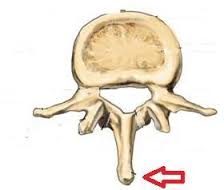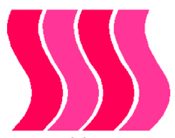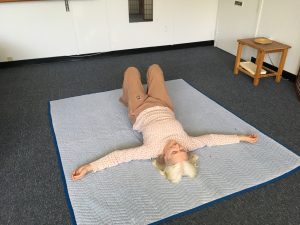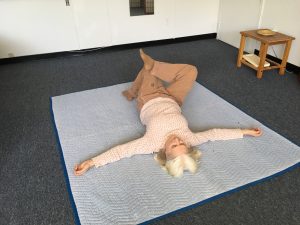Dana came in today for a private session with a painful neck. She wanted some movements that she could do again at home.
We began with her lying on the floor with knees bent and just settling in for a moment. Then she crossed the right ankle to the left knee and with exhale lowered the joined legs to the right (same side as the knee that is in the air). Then with inhale return to the center. In this sequence, you do not continue to the other side. The move brings on a gentle twist. It also makes a demand on the left foot for support of the weight.. I asked her to visualize the path of the twist through the back.
 Each vertebra (except the first)) has a spinous process. This is the bony projection that points to the back and that you can feel in your own or someone else’s back. In the image right the spinous process is indicated with a red arrow.
Each vertebra (except the first)) has a spinous process. This is the bony projection that points to the back and that you can feel in your own or someone else’s back. In the image right the spinous process is indicated with a red arrow.
When Dana began, all the spinous processes were pointing to the center of the earth. As she lowered her joined legs, the spinous processes of the lowest vertebrae changed their pointing, but those of the upper vertebrae did not. I asked her to follow in her mind’s eye how the change in pointing progressed. Lowering the legs is easy! But following the path of the twist takes serious mental effort!
Later we explored a twist of the upper body to the left, and then the combination legs right and upper body left. And later still, all of the above to the other side.
This sequence is described in Feldenkrais’ book Awareness through Movement, Lesson 5. The idea is to invert the usual relationship between neck and body. Usually, in turning, the body stays fairly still and the head and neck make obvious movements. When something goes wrong for the neck, it often helps to lie down, keep the head quiet, and, by contrast, activate the rest of the body.
At the end of our time together today, Dana felt much better in her neck, and elsewhere. She felt that her back was more directly underneath her neck and head.
The explanation is that the twisting movements enlivened the back so that it could take its rightful place — supporting the neck and head from below.



